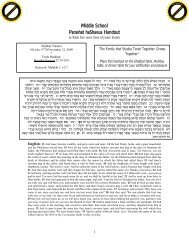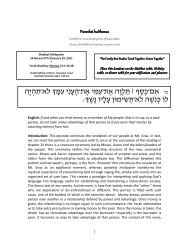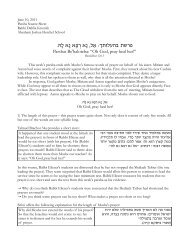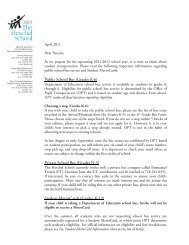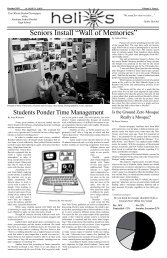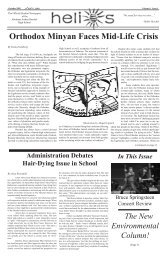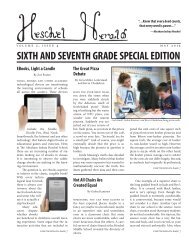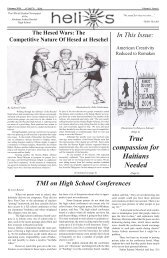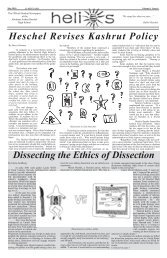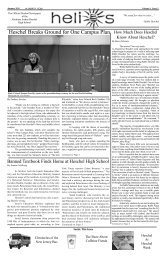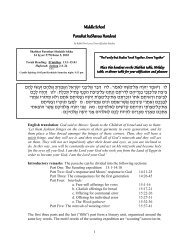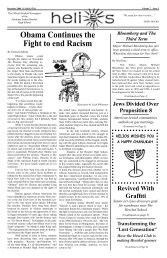Volume 1, Issue 5 (June 2011) - The Heschel School
Volume 1, Issue 5 (June 2011) - The Heschel School
Volume 1, Issue 5 (June 2011) - The Heschel School
You also want an ePaper? Increase the reach of your titles
YUMPU automatically turns print PDFs into web optimized ePapers that Google loves.
Yom Hashoah at <strong>Heschel</strong><br />
By Ben Shapiro<br />
On the morning of May 2, sixth and<br />
seventh graders came to school wearing<br />
dark pants and white tops to mark<br />
the remembrance of the six million Jews<br />
killed during the Holocaust. First there<br />
was a reading of poetry and then there<br />
was a special guest speaker, Ray Kaner;<br />
she was introduced to describe her experiences<br />
as a survivor of Auschwitz.<br />
Ray spoke of starvation, horrible<br />
disease, cruel punishments, and the loss<br />
of loved ones. She had personally experienced<br />
all of this, and she said that, “the<br />
luckier ones died from illness in their<br />
own home; my mother and father were<br />
‘fortunate’ enough to experience this, but<br />
my two brothers weren’t so lucky and<br />
died painfully at the hand of German<br />
soldiers.” Ray revealed that one of the<br />
worst parts of her experience was the<br />
feeling of starvation. She only received<br />
one slice of bread in the morning, nothing<br />
for lunch, and a small bowl of soup<br />
for dinner. Later, conditions became<br />
worse, when she only had one bowl of<br />
soup to share with nine others for the<br />
entire day. It takes a great deal of courage<br />
to speak of times that were so painful,<br />
but she feels it is important that her<br />
story is heard, and passed on to a new<br />
generation.<br />
Candles were lit in the memory of<br />
all those who perished.<br />
During T.S.B.P that day, everyone<br />
went to the memorial, set up every year<br />
in the lower school lobby, to light candles,<br />
and watch a slide show of the many<br />
<strong>Heschel</strong> family members who died.<br />
Some students served as quiet guards; to<br />
silently protect the lit candle in the center<br />
of the room at the lower school.<br />
At eleven o’clock that morning a siren<br />
went off in memory of the millions<br />
who died, and no matter where students<br />
were, everyone stood in silence to listen<br />
and remember. ◆<br />
A Celebration of<br />
Independence<br />
By Sonia Epstein<br />
On Tuesday, May 10, Jewish adults,<br />
children, and Israel supporters alike<br />
celebrated Israel’s hard-fought independence.<br />
It was celebrated, in Israel, countries<br />
all around the world, and at the<br />
<strong>Heschel</strong> <strong>School</strong>.<br />
First, let us go back sixty-three years,<br />
to May 13, 1948. <strong>The</strong> British Mandate was<br />
about to expire; the British Mandate was<br />
the period of time when the British governed<br />
Palestine, the country now known<br />
as Israel. After World War I, the British<br />
seized Palestine from the Ottoman Empire<br />
of Turkey. After some time, because<br />
there had been so much war in Palestine,<br />
the British didn’t want to be involved<br />
with the country anymore. <strong>The</strong>ir plan<br />
was to divide the state between the Jews<br />
and the Arabs, but the Jews had other<br />
plans. This was their chance to take the<br />
state they had always wanted. If they<br />
acted, they would have to do so right after<br />
the British Mandate expired, which<br />
would be in twenty-four hours.<br />
<strong>The</strong>re was a lot to be done in so little<br />
time. First, the Administration had to<br />
decide on a name; David Ben-Gurion<br />
suggested the name “Israel.” <strong>The</strong>n they<br />
had to find a place to hold the reading of<br />
the Declaration of Independence. <strong>The</strong>y<br />
decided that the Tel Aviv Museum, on<br />
Rothschild Boulevard would be the best<br />
place. Most important, they had to write<br />
a Declaration of Independence. David<br />
Ben-Gurion and twelve members of the<br />
Administration wrote it together. <strong>The</strong><br />
first issue was whether to mention God<br />
in the Declaration of Independence.<br />
Once more, David Ben-Gurion solved<br />
the dilemma, and decided to use the<br />
phrase “Rock of Israel.” He convinced<br />
half the Administration that this referred<br />
to God, and the other half that it<br />
did not.<br />
On Friday, May 14, 1948, about 250<br />
people gathered at the museum, and<br />
many more turned on the radio to hear<br />
the proclamation. It contained three sections:<br />
first was the reading of the Declaration,<br />
and the signing of the Council<br />
members’ names to it; second, was the<br />
reading of the first laws that would begin<br />
to govern Israel; finally, Israel’s national<br />
anthem “Ha-Tikvah” was played. At 4:38<br />
pm, David Ben- Gurion declared the assembly<br />
officially over. <strong>The</strong> State of Israel<br />
had been established.<br />
Sixty-three years later, Israel’s independence<br />
is celebrated at <strong>Heschel</strong>. This<br />
year celebrations included: learning<br />
Israeli songs and dances, eating Israeli<br />
food, watching Israeli movies, creating<br />
posters to encourage travel to Israel,<br />
Israeli military training, and learning<br />
about Israeli history. One student commented,<br />
“<strong>The</strong> Israeli dancing was great<br />
fun, and other parts of the festivities<br />
were wonderful too.” All in all, it was<br />
a day to be celebrated. Happy Birthday,<br />
Israel! ◆<br />
Synagogue, cont’d from page 7<br />
the word “Kadosh” (holy) traced three<br />
times each in a different color. Originally<br />
Rabbi Cohen wanted it to read<br />
“Kadosh” three times, but since there was<br />
not enough room, Wright traced it three<br />
times instead.<br />
Lining the walls opposite the sanctuary<br />
are little triangular lights with<br />
plastic three-dimensional pyramids<br />
directly on top. <strong>The</strong> lights are actually<br />
models of the Star of David. Facing<br />
directly in the center of the chapel<br />
is (again) a triangular light filled with<br />
many colors. <strong>The</strong> light was actually inspired<br />
by the kabalistic idea that God<br />
has many sides, and that idea is shown<br />
through the eighteen different colors.<br />
After looking inside, we were lead<br />
outside into the warm Pennsylvania air<br />
to look at the exterior of the building.<br />
<strong>The</strong> pyramid building, costing about 1.3<br />
million dollars to build, resembles a tepee.<br />
This design was meant as a tribute<br />
to the American Indian motif, which<br />
was part of Wright’s idea of the American<br />
Synagogue. Sadly, Frank Lloyd<br />
Wright never lived to see the completion<br />
of this masterpiece. A masterpiece<br />
that was praised as, “an immortal gift to<br />
Frank Lloyd Wright’s memory,” and as<br />
“a singular gift to American Jewry.” ◆<br />
12 ◆ <strong>Heschel</strong> Herald, <strong>Volume</strong> 1, <strong>Issue</strong> 5 <strong>The</strong> Abraham Joshua <strong>Heschel</strong> <strong>School</strong>



